The longitudinal milling machine is a heavy portal-type machine, which is used for processing large-sized parts under conditions of increased loads. Along the X and Y axes, the load falls on the desktop with increased bearing capacity(enlarged flat guides), which is integrated into the machine frame. A powerful milling head will move along the Z axis.
Milling machines with console. These machines can perform a variety of machining. These are unique and small serial production machines. Cantilever milling machines are the main group of milling machines. They have them main feature like them given name, a console that supports the desktop. Thanks to the table fixing system, these machines are designed for small parts that require a wide range of operations.
Thus, it is possible to process milling machines with console: flat or profiled surfaces, channels different types, cams, gears, screws, etc. After the position of the main shaft, these machines can be. The horizontal axis of the main shaft of the machine is horizontal.
Longitudinal milling machine
The longitudinal milling machine is indispensable for working with large and medium-sized parts that require milling. The surface of these parts can be any - horizontal, vertical, inclined - a longitudinal milling machine will cope with any task.The layout of the longitudinal milling machine: a movable table, a rigidly fixed portal with a movable cross member provide rigidity and allow you to process both high and low parts using the optimal capabilities of the machine (simultaneous milling of a workpiece from 3 sides).
Vertical, where the main shaft is mounted vertically. Vertically, the table can rotate horizontally with a certain angle in both. path. Horizontal milling machines consist of a base plate 1, to which is attached a frame 2, which is provided on the front guide posts 3, along which a movable console 4, operated in the vertical direction of the lead screw. There are options that provide rigidity. The best console. The console is provided with horizontal guides 6, perpendicular to the guides on the frame, along which the transverse sleeve 7 moves, and in this longitudinal direction the desktop 8.
Metal processing on a longitudinal milling machine takes place in three stages: first it is rough, then rough and finish. At the finishing stage, any deformations and blots are excluded. The part comes out smooth with a beautiful section without any defects.
Advantages of using longitudinal milling machines of this type:
- fast speed of movement of the table and spindle stocks;
- increase in the speed of lifting and lowering the traverse;
- fixing cutters for working with surfaces of different thicknesses;
- machines with rotary headstocks allow you to change the angle of the cutter.
On milling machines, you can process flat or shaped surfaces, cut threads, splines, teeth, drill and boring work. Milling machines make up a significant part of the stock of machine tools in the USSR - about 10% (up to 180,000 machines); by 1965, it is planned to increase the fleet of milling machines up to 12.7%.
Of all the milling machines, the most widely used are machines for processing flat and curved surfaces: console milling, consoleless milling, longitudinal milling and copy milling. Of the machines for other types of milling, gear milling, thread milling, spline milling and keyway milling have become widespread. In mass production, mainly multi-spindle longitudinal milling machines and machine tools are used. continuous action- carousel-milling and drum-milling.
Replenishment of the fleet of milling machines is carried out at the expense of modern models produced by domestic machine-tool factories.
One embodiment of a milling spindle is shown in the figure showing a threaded rod 10 of a holding mandrel or port milling tool on a conical inner surface main shaft, and drive them up. Rice. 10 Design of the main shaft in horizontal milling machines.
Vertical milling machines resemble horizontal milling machines. The difference between the two is that the main tree is oriented differently. In vertical milling machines, it was necessary to change the upper part of the rod as milling head 11.
Console milling machines
This is the most common type of machine used for milling work. The console milling machines got their name from the console bracket (console), which moves along the vertical guides of the machine bed and serves as a support for the horizontal movements of the table.
The simplest and most common type of equipment used for milling work is horizontal milling machine.
On fig. 7 shows a horizontal milling machine manufactured by the Gorky Plant of Milling Machines. Horizontal milling machines are designed to work with cylindrical and disc cutters, but they can also work with face mills.
In terms of construction, there are several options for vertical milling machines. With fixed friction and non-removable main shaft. With fixed milling head and axial offset main shaft. With axial offset milling head. With inclined milling head and main or axial removable main shaft.
With inclined and axial offset milling head. Rice. 11 Vertical milling machines. Universal milling machines resemble horizontal milling machines with the possibility of additional adjustment movements. Thus, these machines can be processed into pieces with a high degree of complexity.
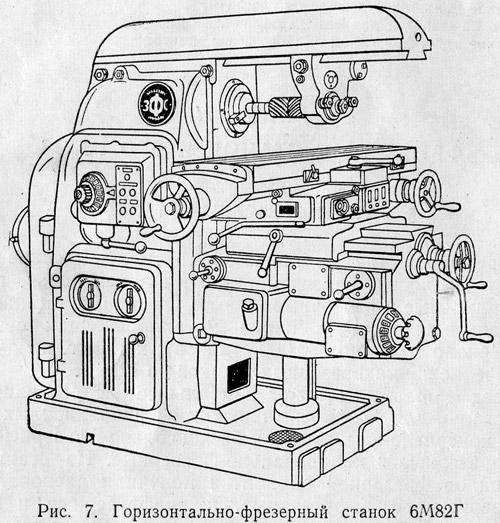
Spindle horizontal milling machine, on which the tool is attached, rotates around a horizontal axis. It receives rotation through the gearbox from the electric motor.
Table The horizontal milling machine has three directions of movement: (longitudinal, transverse and vertical. These movements of the table, or its feed, can be carried out manually using handles or mechanically from the drive of the machine.
Some horizontal milling machines can rotate the table relative to the spindle. Machines with such a rotary table are called universal horizontal milling, or, for short, universal milling machines. On fig. 8 shows a machine of this type. The machine table can be rotated along the circular guides on the top of the slide by 45° in each direction and, after setting to a given angle on scale 1, is fixed with a screw. In addition to the ability to rotate the table, the universal milling machine is no different from the horizontal one.
The adjustment movement can be performed by a tool or a workpiece by turning it. table. Cars in the latter category are also called a turntable. Also, the car differs from the horizontal milling machine in that table. the work can rotate horizontally at a certain angle. For this purpose, the transverse entrainment 7 and the working table 8 are introduced together with the pusher 13. The table rotates at an angle of ± 45 °. After adjustment, during the grinding process. the mass is locked into position.
A distinctive category are universal milling machines. Instrumental. The universal milling machine for sorting is designed for processing small complex parts. Of these, cutting tools of various types are complex geometric bodies, the implementation of which is very difficult.
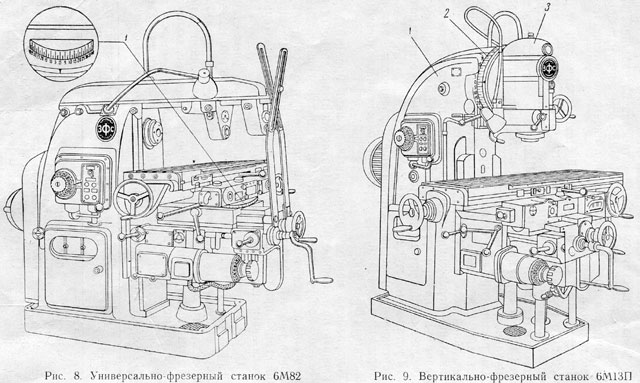
Shown in fig. 9, the milling machine differs from the considered horizontal milling machine only in the arrangement of the upper part of the bed, while the rest of the machine components are the same (compare Fig. 9 and 7). The spindle of this machine rotates around a vertical axis. This type of machine is called vertical milling.
To expand the possibilities of use, new models of vertical milling machines are made with a swivel spindle head 3. It can (be installed both in a vertical position and at an angle to the table plane. This is especially convenient when milling inclined surfaces. The necessary rotation of the spindle head 3 relative to the bed 1 is set to scale 2.
Vertical milling machines are designed to work with end mills, milling heads, end and key cutters.
It is customary to characterize the standard sizes of console milling machines by the size of the working (fixing) surface of the table. Console milling machines can have horizontal universal and vertical execution with the same size of the working surface of the table. The combination of different versions of the machine with the same basic dimensional characteristic of the table is called size range of machines.
In the USSR, the production of console milling machines of five sizes has been mastered: No. 0; No. 1; No. 2; No. 3 and No. 4, and for each size a full range of machines is produced - horizontal, universal and vertical. Each machine of the same size range has the same designation in the cipher, corresponding to the size of the working surface of the table.
Depending on the size of the working surface of the table, the following sizes of console milling machines are distinguished:
These tools can be machined on custom-made machines with a wide range of adjustments and with a wide variety of devices. Such a machine is also a universal milling machine to validate your current path when fitting cleaning sections in dies and prototypes. This machine, using special accessories, can work as a horizontal milling machine, vertical milling machine, high-speed vertical milling machine, drilling machine, vertical drilling machine.
The destination of the car is changed by installing special heads, namely: horizontal milling head, vertical milling head, fast milling head, milling head. Drilling can be done using a vertical milling head or a fast milling head.
Change according to the size of the table dimensions the machine itself and its main components (bed, table, sled, console, trunk), the power of the electric motor and the magnitude of the greatest movement (stroke) of the table in the longitudinal direction, the sled in the transverse direction and the console in the vertical directions.
On fig. 10 graphically shows the largest movements of the table, sled and console.
In addition to these accessories, the vehicle is also equipped with several tables that allow the workpiece to be positioned relative to the tool. These include: a separator table, a horizontal table, and a mass with a spatial orientation of the piece. Bicycle 1 is equipped with 2-point soles for mounting on the ground and gearbox. On the front rails 4, a vertical table 5 slides on which some of the machine's accessories can be mounted, as is the case with the horizontal table 6. The top of the rod is the horizontal rails 7, which can move or block the horizontal milling head 8, which supports the horizontal main shaft.
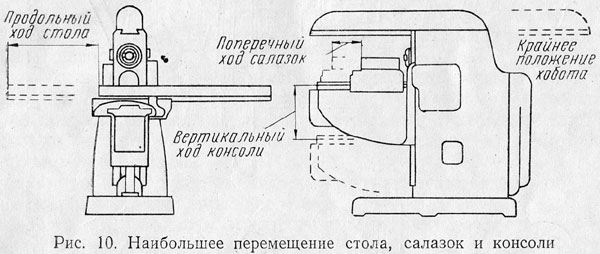
On the basis of the main models of console milling machines, modifications are produced that allow expanding the scope of machines of this range. So, on the basis of vertical milling machines 6M12P and 6M13P, machines 6M12PB and 6M13PB are produced, which have high spindle speeds (high-speed modification), which makes it possible to use these machines for processing light alloys.
On the basis of universal milling machines, their modifications are produced with an additional vertical head. The wide universal milling machine 6M82SH (Fig. 11) is a modification of the horizontal milling machine 6M82G. It has two spindles, one of which is horizontal, as in the 6M82G machine, the second is located in the swivel head and can be set at an angle of ±90° in the longitudinal plane of the table and at an angle of ±45° in the transverse plane of the table. A wide variety of milling operations, as well as drilling, boring holes, trimming ends in different planes of the workpiece can be performed on wide-purpose machines from one of its installations. 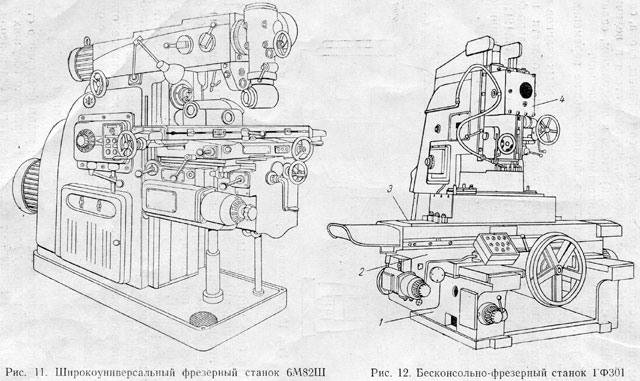
Universal milling machine for cleaning. In FIG. 13 a - horizontal milling head 8; Console 4 and bearing 15 are used to increase the stability of the spindle axis 16. The vertical milling head 17 is installed above the horizontal, after removing the top plate 9; It is noted that in this case the main shaft, in which the tool is fixed, has a vertical position.
The fast milling head is mounted in the same way as the vertical milling head. The fast movement is achieved by means of an electric motor 9 which, via a trapezoidal belt 20, drives the main shaft 18 into which cutters or drills can be hooked.
Consoleless milling machines
The console is the weakest node of the milling machine in terms of rigidity, therefore, for high-speed processing of large and heavy parts, milling machines without a console, the so-called consoleless milling machine tools; however, such machines are less versatile than console ones.
On fig. 12 shows a consoleless vertical milling machine manufactured by the Gorky Plant of Milling Machines. The table 3 of the machine has a longitudinal movement along the horizontal guide rails 2, which have a transverse movement along the guides of the frame 1. Thus, the table of consoleless milling machines has only horizontal movement in the longitudinal and transverse directions (cross table). The spindle head 4 receives vertical movement along the vertical guides of the rack.
Clamping head 21 turns the milling machine into a mortise machine. Rice. 13 Accessories for universal milling machines for sorting. Longitudinal milling machines. Longitudinal milling machines are designed to process flat surfaces into large pieces. The work table makes one forward movement, resting completely on the rails of the chassis. The rigidity of these machines allows the use of intensive modes of operation, the quality of the processed surfaces is superior.
Figure 14 shows a number of machine designs. Longitudinal milling. Rice. 14 Design Options longitudinal milling machines. The shape of the bead is determined by the number, position and processing capabilities of the working heads. Portal milling machines can have two, three or four milling heads.
Longitudinal milling machines
Horizontal milling machines different sizes, because as the size of the workpieces to be processed increases, milling machines with large desktop sizes are required.
At the machines big size it becomes inconvenient to raise and lower the table console, so these machines have lifting console tables are replaced by tables having only longitudinal movement. Such machines are called longitudinal milling.
Longitudinal milling machines are designed for surface treatment of large workpieces.
The scheme for constructing such a four-point milling machine is shown in Figure 15. Fig. 15. 15 Construction of longitudinal portal milling machines. In order to ensure the rigidity of the system, working in any position, the length of the frame is twice the length of the table. Spindle center sleeve 8 of 9 allow movement of the positioning performance is to establish the distance between machined surfaces or the depth of penetration of the cutting tool. The car frame together with two columns and cross member 7 form a closed and rigid frame.
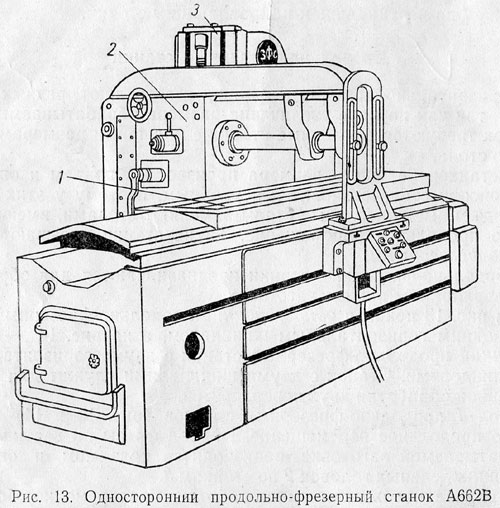
On fig. 13 shown unilateral longitudinal milling machine with one horizontal spindle, and in fig. 14 - bilateral longitudinal milling machine with two horizontal spindles. A machine with two spindles is used for the simultaneous processing of two surfaces.
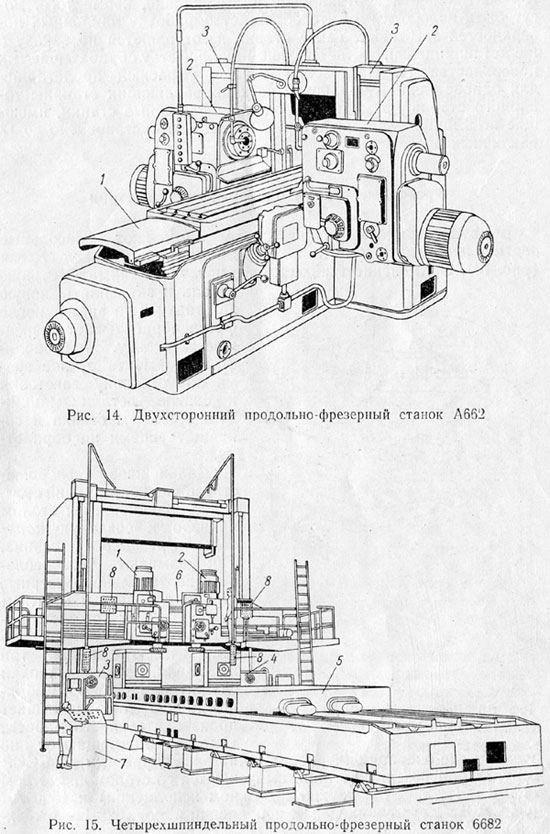
Table 1 of longitudinal milling machines (Fig. 13 and 14) has only longitudinal movement. The cutter is approached vertically to the workpiece being processed by raising and lowering the spindle heads 2 along the racks 3.
If it is necessary to process more than two surfaces at the same time, apply multi-spindle longitudinal milling machines having, in addition to horizontal, also vertical spindles. On fig. 15 shows a four-spindle longitudinal milling machine with tables 3.6X12 m, designed to process four surfaces of large-sized workpieces weighing up to 120 tons, up to 12 m long, up to 3.6 m wide and high, from three sides.
The machine has four rotary spindle heads: two vertical 1 and 2, located on the traverse (crossbar) 6, and two horizontal 3 and 4, located on the side racks. Table 5 of the machine has only longitudinal movement.
The vertical installation of the spindle heads 1 and 2 is carried out by moving the traverse 6 along the machine stands, and the transverse (lateral) installation - by moving the heads themselves along the traverse 6.
The vertical installation of spindle heads 3 and 4 is carried out by moving them along the machine stands.
The machine is controlled from the central console 7. The required number of revolutions of each spindle is set using the handles located on each spindle head.
There are two push-button stations and two suspended panels 8, duplicated with each other and located at each spindle head.
Longitudinal milling machines are manufactured in the USSR in various sizes, ranging from small machines (Fig. 13 and 14) with a table size of 450X1600 mm to giant machines, like the one shown in Fig. 15. Spindle heads can have a horizontal and vertical arrangement, in addition, can be rotated, which facilitates the processing of inclined surfaces of the workpiece. Such machines are made to order with the number of spindles corresponding to the number of surfaces to be machined. At the Moscow plant "Red Proletarian" for the simultaneous processing of all bed guides lathe longitudinal milling machines are used, having 9 spindles each, on which up to 17 different cutters can be installed.
Circular feeding milling machines. In milling machines with round feed, the workpiece performs a low-speed rotation. This allows the machine to run continuously, pick up and detach the part while walking, using specialized devices. The desktop can be oriented in a vertical or horizontal plane.
The circular advance is carried out by the machine table. Rice. 16 Circular milling machines. It is off, to work on a milling machine with clothes or cuffs apart, because they can easily get into the moving parts of the machine. Before starting work, check the condition of the milling machine.
Continuous Milling Machines
In large-scale production, cantilever vertical milling machines are used with round turntable(Fig. 16). The use of such machines allows you to remove the finished part and fix a new workpiece at a time when the cutter is processing the next workpiece. This allows you to overlap the manual time for setting the workpiece and removing the part by the machine time and reduce the time for processing.
Before starting the electric motor, it will turn off all the control levers that secure them in the desired position. The milling machine will stop when a catch or turn off the track when changing cutters when they are about to chip or the milling machine is clean and oiled. Any power interruption will shut down the motor, even if the interruption is temporary.
Before starting work, make sure that the cutters are well sharp, if they have the right profile for the work being done and the material they are made from. The mills will fit well into the tool port. The workpiece will fit snugly so that it does not stretch or open during operation.
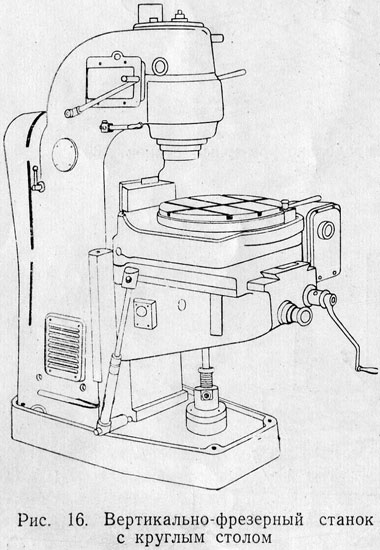
Further improvement in the design of rotary table machines led to the creation rotary milling machine. This is the name of consoleless vertical milling machines with a large round rotating table like a carousel. Such machines have two or three spindles, one of which is used for finishing, which also increases productivity, since two operations (roughing and finishing) are combined in time. In the USSR, rotary milling machines are produced with a table with a diameter of 1000 mm (mod. 621 in a two-spindle version) and 1500 mm (mod. 623 in a two-spindle version and mod. 623B in a three-spindle version).
His commercial activity in the most demanding milling, vertical and vertical milling markets such as Germany, China, Italy, Brazil, India and Russia, has focused on sectors such as railway, energy, naval, engineering and transport manufacturing.
Thus, when loading a brooch smaller than the programmed one, the machine can increase the feed rate, thereby reducing the processing time. In contrast, when the workload is higher than planned, the machine automatically slows down the feed to protect the machine and space.
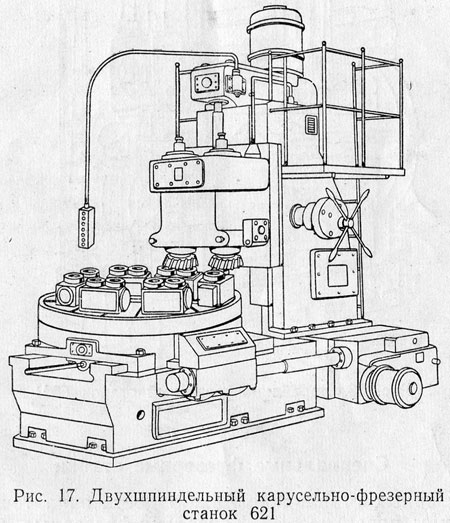
On fig. 17 shows a two-spindle rotary milling machine mod. 621 produced by the Gorky Plant of Milling Machines.
For simultaneous continuous processing of workpieces from both ends, drum milling machines. On a drum-milling machine (Fig. 18), the workpieces are fixed on a round, rotating around a horizontal axis, drum table in such a way that both ends of them can be simultaneously processed alternately by roughing and finishing cutters.
Designed for compactness and economy. High performance and efficiency provided by high torque and direct drive brooches. A wide range of accessories that can be installed in working space to improve production capacity.
- Long-lasting precision resulting from rigorous design and assembly.
- Optimal rigidity and mechanical stability.
- High precision and machining accuracy in one machine.
- Customizable machine thanks to the huge variety of heads and options available.
- Full splash protection.
- High flexibility and high results with high precision.
- Pendulum processing minimizing non-productive times.
- First-class ergonomics and low cost.
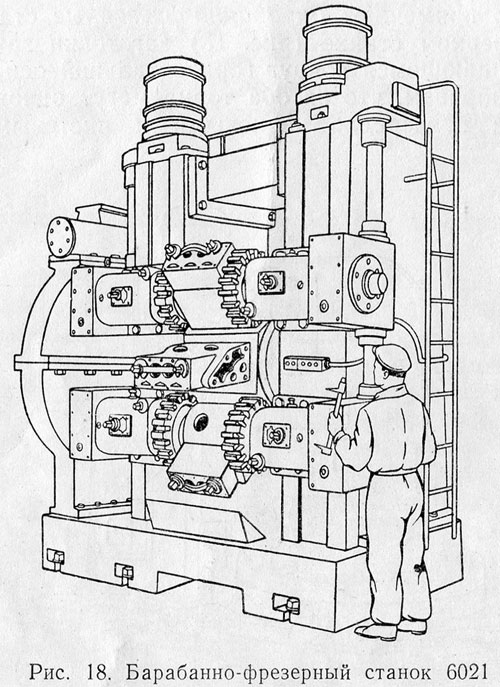
The processing on a drum milling machine of workpieces in which both ends are processed will be twice as productive as compared to a carousel milling machine. The clamping of blanks and the removal of parts on drum milling machines are also carried out continuously during processing. In the USSR, drum-milling machines with a drum diameter of 1000 mm (mod. 6021), 650 mm (mod. 6022) and 900 mm (mod. 6023) are manufactured.
Carousel-milling and drum-milling machines are widely used for processing workpieces of car and tractor body parts at ZIL, MZMA, GAZ, MAZ, KhTZ, LTZ, VTZ, Zavolzhsky motor and other plants in large-scale and mass production.
Description and principles of operation of a metal-cutting machine or a metal-cutting machine
Remarkably versatile - efficient and precisely customizable to suit any customer need thanks to the wide range of options available. A wide range of automatic heads, milling heads, feathers and special heads. Density center across the entire range: improved stability and reduced foundation costs. Rigid and stable construction for maximum precision: The machine has been designed using the finite element method and tested for maximum rigidity to minimize the vibration problem. High forward forces for the cross axis and booklet, resulting in the removal of large volumes of material. High load design and high dynamism provide optimum power and cutting speed. The very rigid construction and armor-piercing brooch, combined with thermal stability, ensure long-term accuracy. The configuration of the machine allows the operator to be close to the working area, which makes it easy to assemble, measure, etc. A wide range of portal milling and boring machines: mobile table, portal, mobile gantry. Multifunctional - integration of various machining processes such as milling and drilling for medium components that can be machined on the same machine in one setup. High precision and durability thanks to rigorous design and assembly processes. Personalized efficiently and precisely for any specific customer need thanks to the many options available. Perimeter protection or full machine encapsulation on request.
Distinctive features and criteria
- Accurate and efficient processing results.
- Optimum mechanical rigidity and stability.
- Large material and precise removal in one machine.
Special milling machines
On milling machines, it is possible to accurately process all types of surfaces. Console milling, consoleless milling, longitudinal milling and machines continuous action are machines general purpose and can be used for processing blanks of a wide variety of parts.
Unlike general purpose machines, milling machines are used to perform certain milling operations. designated purpose. These machines include gear milling, thread milling, keyway milling, etc.
In connection with the development of large-scale and mass production, milling machines are now being widely introduced into production, designed to produce parts of a certain configuration. These machines are designed for maximum productivity and are often automated. Unlike machine tools for their intended purpose, they are called special. Machine tools used in the watch industry are among the special ones; machines for milling drills, taps, reamers; machines used in the automotive, tractor and machine tool industries for milling on automatic and production lines; copy-milling machines, etc.
Due to the rapid development of technology, products often change configuration, so the use of special milling machines, which, unlike general-purpose machines, do not allow them to be readjusted to process any workpieces, is not always beneficial.
V last years the so-called aggregate milling machines that allow the production of any combination of their constituent interchangeable unified units (assemblies) in accordance with the configuration of the manufactured part and the location of the surfaces to be machined. To switch to the processing of other workpieces, it is enough to change or reconfigure the individual units of the aggregate machine. On fig. 19 shows an aggregate milling machine.
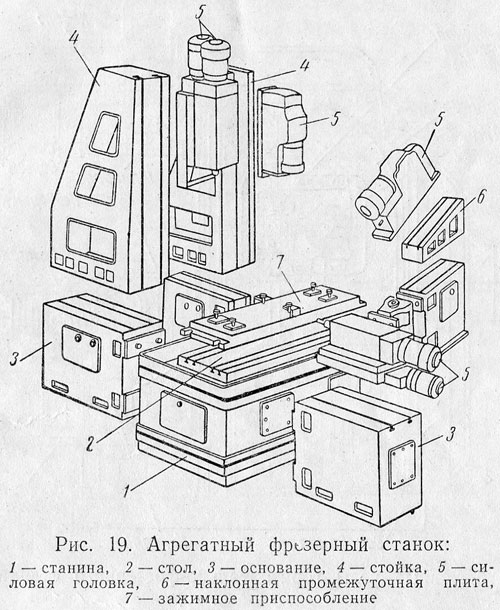











History of sky lanterns
Job description: concept, purpose, structure, procedure for compiling and formalizing Purpose and content of job descriptions for managers
Interview questions What job are you going to work on?
What to do if the boss criticizes all the time If the boss does nothing
How to understand: will the kitten be fluffy?